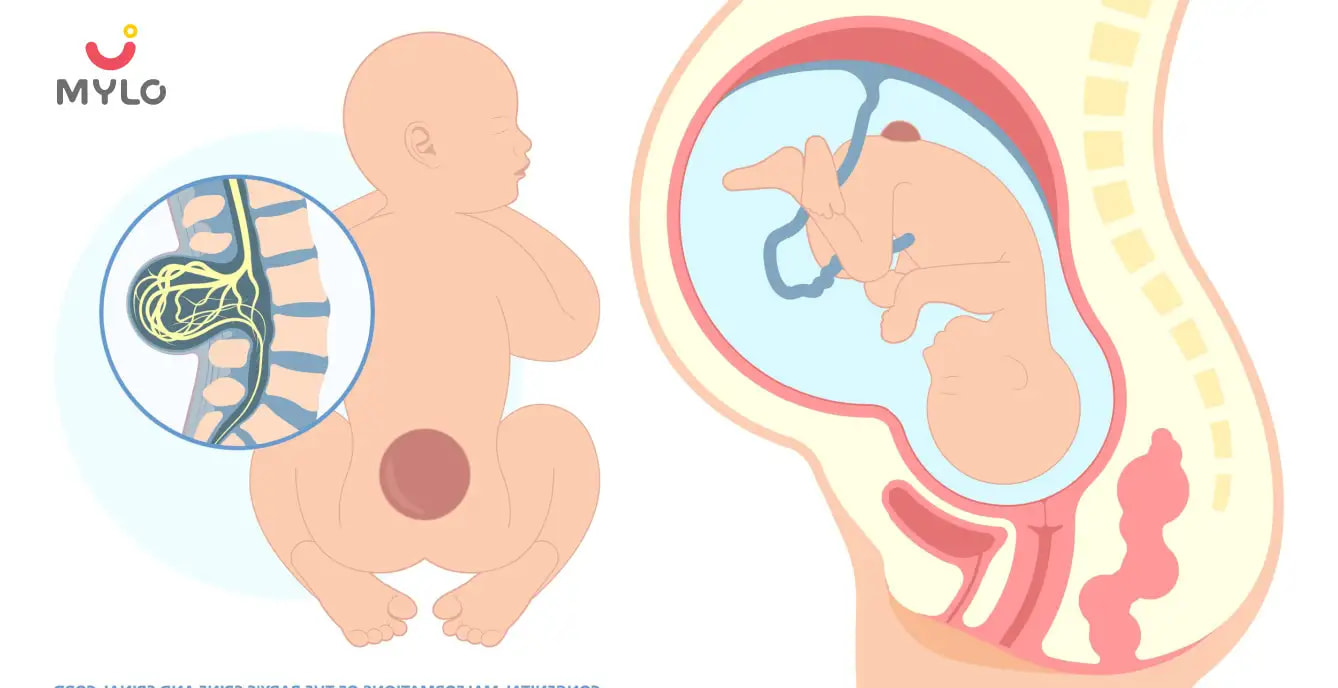Home

Developmental Disorders

Myelomeningocele: Symptoms, Causes & Treatment
In this Article

Developmental Disorders
Myelomeningocele: Symptoms, Causes & Treatment
Updated on 3 November 2023
What is myelomeningocele?
Myelomeningocele meaning: A form of birth abnormality that occurs when the baby's developing spinal cord does not develop normally. It is also called myelomeningocele spina bifida, which means incomplete closure of the spinal canal after birth.
This birth defect can be recognized before birth. It can be corrected either during pregnancy or shortly after.
It is a specific kind of neural tube defect. The embryonic structure known as the neural tube eventually gives rise to the baby's brain, spinal cord, and surrounding tissues. It appears as a fluid-filled sac protruding from the baby's spine.
What exactly is a neural tube defect?
A neural tube is a ribbon-like structure that rolls and becomes a tube-like structure. It starts forming one month after conception. It forms the baby's spine and brain as the pregnancy progresses. A neural tube defect (NTD) occurs when this tube fails to close properly. Birth defects of this kind start quite early in the pregnancy. Most of the time, even before the woman knows she is pregnant. NTD results in brain or spine defects.
Difference between spina bifida and myelomeningocele?
Spina bifida is a condition where the baby's neural tube in the area of the spine fails to close fully. This can happen in any region of the spinal cord. When this occurs, a baby's backbone, which safeguards its spinal cord, fails to properly develop and close. This results in damage to the baby's nerves and spinal cord.
myelomeningocele Spina bifida is a severe form of this condition. It appears as a fluid-filled sac on the back of the baby, from which a part of the nerve and the spinal cord protrude. Other types of spina bifida include myelocele and spina bifida occulta.
Difference between meningocele and myelomeningocele?
Both myelomeningocele and meningocele are types of spina bifida.
Meningocele: This is seen as a fluid-filled sac on the baby's back, but the spinal cord is not within the sac. It is rare to see any nerve damage.
In myelomeningocele, there is damage to a part of the baby's nerve and spinal cord. A part of the spinal cord and nerve is seen in the fluid-filled sac. It is one of the most common birth defects related to the nervous system.
Who is affected by myelomeningocele?
It is a condition that is more common in whites and Hispanics. Females are more affected than males. children with other genetic abnormalities or associated NTD defects.
Is myelomeningocele common?
In the United States, myelomeningocele affects over 1,645 newborns each year, making it the most prevalent congenital disorder of the central nervous system.
Symptoms of myelomeningocele
Babies with myelomeningocele will present the following features:
-
fluid-filled sac in the mid- or lower back area along the spine
-
Other birth defects are seen along with this fluid-filled sac.
-
The majority of children with this condition also have fluid in their brains (hydrocephalus).
-
Other issues seen in children along with myelomeningocele are a fluid-filled cyst on the back (Springomyelia), and hip dislocation.
Causes myelomeningocele
-
Folate deficiency in the mother raises the baby's risk of NTD.
-
Family history of NTD. Couples should always meet a genetic counselor before planning to have a child. On the other hand, a lot of cases are solitary and have no familial history.
-
Certain medications, such as anti-epileptic medicines taken during pregnancy, put the child at risk.
-
Mothers with diabetes
-
Obesity in the mother is another risk factor for birth defects in the child.
-
Increased body temperature during the early stages of pregnancy.
Ask the doctor when a higher dose or a prescription of folic acid is needed if there are recognised risk factors for spina bifida, even before becoming pregnant.
Inform the doctor if a drug is being used. Prepare ahead of time, several medications can be changed to reduce the chance of developing spina bifida.
Treatment myelomeningocele
Myelomeningocele is often treated with surgery to close the gap in the baby's spine. Healthcare professionals perform surgery either before or right after delivery.
Frequently, babies with myelomeningocele suffer hydrocephalus (fluid buildup in their brain). They might need a shunt implanted, to help drain the extra fluid from their brain.
Most babies will require lifetime care to manage conditions brought on by injuries to their spinal cord and spinal nerves. Antibiotics to cure or prevent infections like meningitis or urinary tract infections (UTIs), as well as physical therapy, are common therapies.



Written by
Sanju Rathi
A Postgraduate in English Literature and a professional diploma holder in Interior Design and Display, Sanju started her career as English TGT. Always interested in writing, shetook to freelance writing to pursue her passion side by side. As a content specialist, She is actively producing and providing content in every possible niche.
Read MoreGet baby's diet chart, and growth tips

Related Articles
Related Questions
Hello frnds..still no pain...doctor said head fix nhi hua hai..bt vagina me pain hai aur back pain bhi... anyone having same issues??

Kon kon c chije aisi hai jo pregnancy mei gas acidity jalan karti hain... Koi btayega plz bcz mujhe aksar khane ke baad hi samagh aata hai ki is chij se gas acidity jalan ho gyi hai. Please share your knowledge

I am 13 week pregnancy. Anyone having Storione-xt tablet. It better to have morning or night ???

Hlo to be moms....i hv a query...in my 9.5 wk i feel body joint pain like in ankle, knee, wrist, shoulder, toes....pain intensity is high...i cnt sleep....what should i do pls help....cn i cosult my doc.

Influenza and boostrix injection kisiko laga hai kya 8 month pregnancy me and q lagta hai ye plz reply me

RECENTLY PUBLISHED ARTICLES
our most recent articles

Diet & Nutrition
গর্ভাবস্থায় আলুবোখরা: উপকারিতা ও ঝুঁকি | Prunes During Pregnancy: Benefits & Risks in Bengali

Diet & Nutrition
গর্ভাবস্থায় হিং | ঝুঁকি, সুবিধা এবং অন্যান্য চিকিৎসা | Hing During Pregnancy | Risks, Benefits & Other Treatments in Bengali

Women Specific Issues
স্তনের উপর সাদা দাগ: লক্ষণ, কারণ এবং চিকিৎসা | White Spots on Nipple: Causes, Symptoms, and Treatments in Bengali

Diet & Nutrition
গর্ভাবস্থায় পোহা: উপকারিতা, ধরণ এবং রেসিপি | Poha During Pregnancy: Benefits, Types & Recipes in Bengali

Diet & Nutrition
গর্ভাবস্থায় মাছ: উপকারিতা এবং ঝুঁকি | Fish In Pregnancy: Benefits and Risks in Bengali

Diet & Nutrition
গর্ভাবস্থায় রেড ওয়াইন: পার্শ্ব প্রতিক্রিয়া এবং নির্দেশিকা | Red Wine During Pregnancy: Side Effects & Guidelines in Bengali
- ইনার থাই চ্যাফিং: কারণ, উপসর্গ এবং চিকিৎসা | Inner Thigh Chafing: Causes, Symptoms & Treatment in Bengali
- গর্ভাবস্থায় ব্রাউন রাইস: উপকারিতা ও সতর্কতা | Brown Rice During Pregnancy: Benefits & Precautions in Bengali
- Velamentous Cord Insertion - Precautions, Results & Safety
- Unlock the Secret to Flawless Skin: 7 Must-Have Qualities in a Face Serum
- Unlock the Secret to Radiant Skin: How Vitamin C Serum Can Transform Your Complexion
- Gender No Bar: 10 Reasons Why Everyone Needs a Body Lotion
- Unlock the Secret to Radiant Skin How to Choose the Perfect Body Lotion for Your Skin Type
- Top 10 Reasons to Apply a Body Lotion After Every Bath
- Communication in Toddlers: Milestones & Activities
- How to Improve Vocabulary for Toddlers?
- A Comprehensive Guide to Understanding Placenta Accreta
- Vulvovaginitis in Toddlers Causes, Symptoms and Treatment
- A Comprehensive Guide to Understanding Cerebral Palsy in Children
- Bitter Taste in Mouth During Pregnancy: Understanding the Causes and Remedies


AWARDS AND RECOGNITION

Mylo wins Forbes D2C Disruptor award

Mylo wins The Economic Times Promising Brands 2022
AS SEEN IN
















- Mylo Care: Effective and science-backed personal care and wellness solutions for a joyful you.
- Mylo Baby: Science-backed, gentle and effective personal care & hygiene range for your little one.
- Mylo Community: Trusted and empathetic community of 10mn+ parents and experts.
Product Categories
baby carrier | baby soap | baby wipes | stretch marks cream | baby cream | baby shampoo | baby massage oil | baby hair oil | stretch marks oil | baby body wash | baby powder | baby lotion | diaper rash cream | newborn diapers | teether | baby kajal | baby diapers | cloth diapers |








